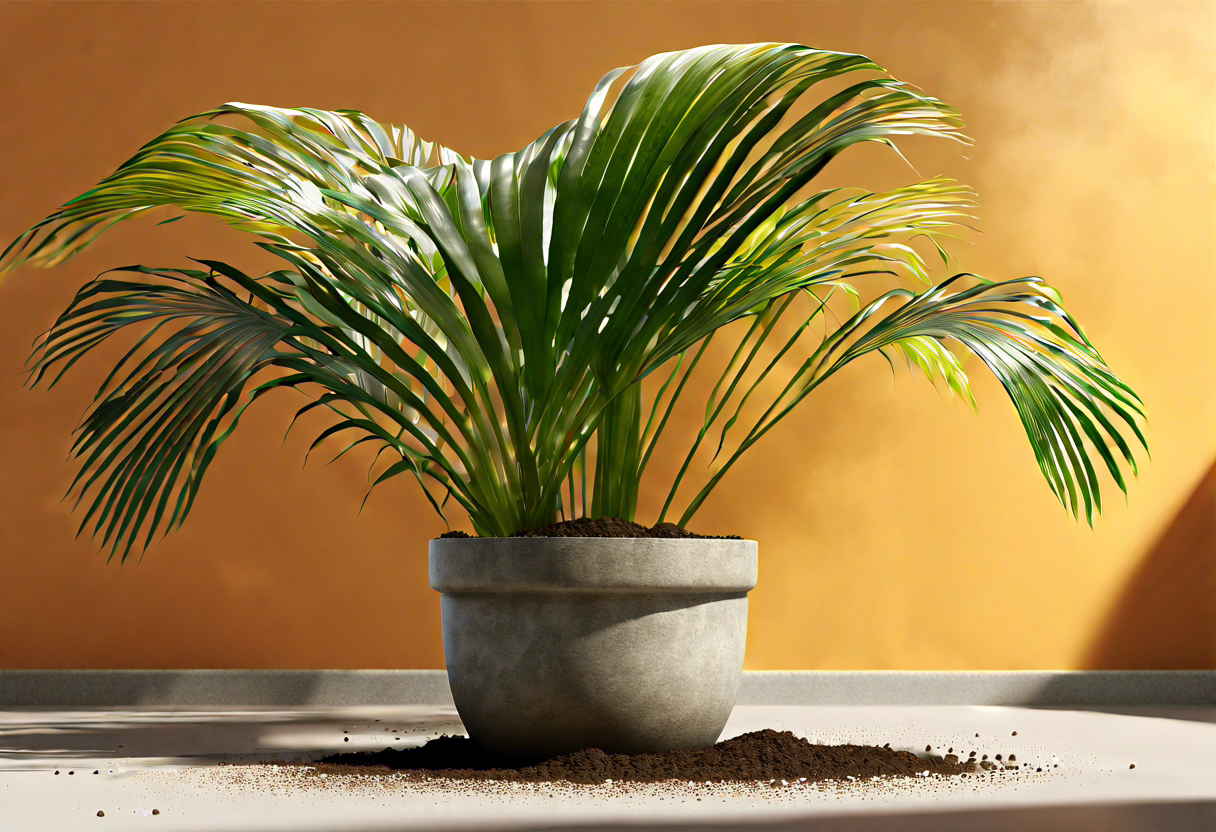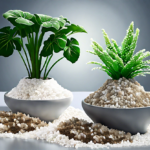Importance of Using the Right Soil Mix for Areca Palm (Dypsis lutescens)
Areca Palm, scientifically known as Dypsis lutescens, is a popular choice for indoor plant enthusiasts due to its elegant appearance and air-purifying abilities. One crucial factor that contributes to the well-being and growth of this tropical beauty is the soil or potting mix it is planted in. Using the right soil mix for your Areca Palm is of utmost importance to ensure its vitality and overall health.
The soil plays a vital role in providing essential nutrients, proper drainage, and a suitable environment for the roots to thrive. The right soil mix promotes healthy root development, allowing the plant to absorb nutrients efficiently. It also aids in water retention while preventing excessive moisture that can lead to root rot. As such, choosing the best soil for your Areca Palm is essential to support its growth and prevent common issues that can hinder its well-being.
When selecting a soil mix for your Areca Palm, certain factors need to be considered. Firstly, it is crucial to choose a well-draining soil that prevents waterlogging. Areca Palms prefer slightly moist soil rather than being constantly wet. A well-draining mix ensures excess water is efficiently drained away, preventing root rot and other moisture-related issues.
The soil should also provide adequate oxygenation to the roots. This can be achieved by using a mix that is light and airy, allowing for proper airflow. Areca Palms thrive in a mix that retains moisture while still providing ample oxygenation to the roots.
Another factor to consider is the pH level of the soil. Areca Palms prefer a slightly acidic to neutral pH range, typically around 6.0 to 7.5. Testing the pH of the soil and adjusting it if necessary can help ensure optimal growth and nutrient absorption for your Areca Palm.
Now that we understand the importance of choosing the right soil mix, let’s take a look at the best soil mixture recipe for Areca Palms. This winning combination can be easily prepared at home by mixing equal parts of peat moss, perlite, and coconut coir. This mixture provides excellent drainage, moisture retention, and aeration, creating an ideal environment for your Areca Palm to thrive.
Selecting the right soil mix is crucial for the overall health and growth of your Areca Palm. A well-draining, oxygen-rich mix with a slightly acidic to neutral pH will provide the optimal conditions for your Areca Palm to flourish. Remember to consider these factors when selecting or preparing a soil mix and enjoy watching your Areca Palm thrive in its new home.
Factors to Consider When Choosing Soil for Areca Palm
Choosing the right soil for your Areca Palm (Dypsis lutescens) is crucial for its overall health and well-being. The soil you select will directly impact the growth, appearance, and longevity of your plant. Here are several important factors to consider when choosing soil for your Areca Palm:
1. Well-Draining Soil: Areca Palms prefer a well-draining soil mix that allows excess water to flow freely. Standing water can lead to root rot and other issues. It is essential to select a soil mix that promotes healthy drainage, preventing waterlogged conditions.
2. Good Aeration: Areca Palms thrive in soil that provides proper air circulation to the roots. Adequate aeration helps prevent the roots from suffocating, allowing them to access essential oxygen. A well-aerated soil mix is essential for the overall vitality and growth of your Areca Palm.
3. Nutrient-Rich Soil: Areca Palms require a soil mix that is rich in nutrients. Opt for a potting mix that contains organic matter such as compost or well-rotted manure. These organic components will provide the necessary nutrients for your Areca Palm to thrive and maintain vibrant foliage.
4. pH Level: Areca Palms prefer a slightly acidic to neutral soil pH. Aim for a pH level between 6.0 and 7.0 for optimal growth. Testing the soil’s pH level and adjusting it accordingly will help create a favorable environment for your Areca Palm.
5. Moisture Retention: While Areca Palms prefer well-draining soil, it is important to select a mix that retains some moisture. The soil should be able to hold enough moisture to provide adequate hydration to the plant between waterings. This will prevent the soil from drying out too quickly and keep the plant healthy.
6. Avoid Excessive Fertilization: Although nutrient-rich soil is essential for the growth of Areca Palms, excessive fertilization can be harmful. It is recommended to use a slow-release fertilizer or organic fertilizers sparingly, following the instructions provided. Over-fertilization can lead to nutrient burn or salt buildup in the soil, which can be detrimental to your Areca Palm.
Choosing the right soil for your Areca Palm is vital for its overall health and growth. Opt for a well-draining, nutrient-rich soil mix that provides good aeration and moisture retention. Keep in mind the preferred pH level and avoid excessive fertilization. By taking these factors into consideration, you can provide the optimal soil conditions for your Areca Palm to thrive and flourish.
Best Soil Mixture Recipe for Areca Palm at Home
When it comes to caring for an Areca Palm (Dypsis lutescens), providing the best soil mixture is essential for its overall health and growth. While these plants are relatively adaptable, using a suitable soil mix will ensure optimal conditions for the palm to thrive. As a palm enthusiast, you can create a customized soil mixture at home that will meet the specific needs of your Areca Palm. By following this simple recipe and understanding the key components, you can provide the best soil mixture for your tropical gem.
To create the ideal soil mixture for your Areca Palm, you will need a combination of well-draining soil, organic matter, and optional additions for enhanced nutrition. Begin by selecting a well-draining potting mix. Avoid heavy soils that retain too much moisture as this can lead to root rot. A mixture of peat moss, perlite, and coarse sand is a great base to promote proper drainage. This mixture allows excess water to drain away, preventing waterlogged soil and potential root issues.
Incorporate organic matter into your soil mixture to improve nutrient content and moisture retention. Compost or well-rotted manure are excellent choices for organic matter. These additions enhance the soil’s fertility and provide a consistent source of nutrients for the Areca Palm. Mix in approximately 20% organic matter with the potting mix to achieve the right balance.
To further enhance the nutrition of your soil mixture, you can include slow-release fertilizers. These fertilizers gradually release nutrients into the soil, providing a steady supply to the Areca Palm over time. Opt for a balanced slow-release fertilizer or one specifically formulated for palm plants. Follow the manufacturer’s instructions for application rates to avoid overfertilizing, which can damage the roots.
When preparing the soil mixture, ensure that it is well-mixed to distribute all the components evenly. Once you have created the desired mixture, fill the pot or container with the soil, leaving enough room for the Areca Palm’s roots to spread comfortably. Gently place the plant into the pot, being careful not to damage the roots. Firmly pack the soil around the base of the plant to provide stability.
Remember that Areca Palms prefer slightly acidic to neutral soil pH levels between 6.0 and 7.0. Regularly test the pH of your soil mixture to monitor its acidity and adjust if necessary. Acidic soil can be neutralized by incorporating limestone, while alkaline soil can be adjusted with sulfur or sulfate-containing products. Maintaining the appropriate pH level will create an optimal environment for your Areca Palm.
Creating the best soil mixture for your Areca Palm ensures its health, growth, and longevity. By combining well-draining soil with organic matter and optional slow-release fertilizers, you can create a customized soil mix that meets the specific needs of this tropical palm. Remember to maintain the appropriate pH level to provide the ideal conditions for your Areca Palm to flourish. With the right soil mixture, your Areca Palm will thrive and grace your space with its vibrant foliage and elegant presence.
Common Mistakes to Avoid in Soil Selection for Areca Palm
Choosing the right soil for your Areca Palm (Dypsis lutescens) is crucial for its overall health and growth. However, there are some common mistakes that many people make when it comes to selecting the proper soil mixture. By avoiding these mistakes, you can provide the ideal environment for your Areca Palm to thrive. Here are some common mistakes to steer clear of:
1. Using Heavy, Compact Soil: Areca Palms prefer a well-draining soil mix that allows excess water to flow out easily. Avoid using heavy, compact soil that retains moisture for long periods. Such soil can lead to root rot and other fungal diseases, eventually causing the demise of your prized plant.
2. Ignoring the pH Level: Areca Palms thrive in slightly acidic to neutral soil with a pH level ranging from 6.1 to 7.5. Avoid using soil with extreme pH levels, as it can hinder nutrient absorption and stunt the growth of your palm. Test the pH level of the soil before potting or consider using a pH-adjusted potting mix.
3. Neglecting Organic Matter: Areca Palms benefit from soil enriched with organic matter, such as compost or well-rotted manure. This organic matter improves soil structure, promotes beneficial microbial activity, and enhances the retention of moisture and essential nutrients. Avoid neglecting the addition of organic matter to your soil mix.
4. Overfertilizing: While it may be tempting to provide your Areca Palm with ample nutrients, overfertilizing can be detrimental to its health. Excessive amounts of fertilizer can lead to salt buildup in the soil, causing root damage and nutrient imbalances. Follow a regular fertilizer schedule but be cautious not to go overboard.
5. Choosing the Wrong Pot Size: The size of the pot plays a crucial role in the overall health of your Areca Palm. Avoid using pots that are too small, as they restrict root growth and affect nutrient uptake. Conversely, avoid using pots that are excessively large, as they can retain excess moisture, leading to root rot. Choose a pot that provides enough room for the palm’s roots to grow without being excessively large.
6. Neglecting Drainage: Adequate drainage is essential for preventing waterlogged soil, a condition that Areca Palms dislike. Avoid neglecting proper drainage in your pot by ensuring it has sufficient drainage holes at the bottom. Additionally, consider using a layer of gravel or broken pottery shards at the bottom of the pot to facilitate better water flow.
7. Using Contaminated Soil: Avoid using soil that may be contaminated with pests, diseases, or weed seeds. Always opt for fresh, high-quality potting mix specifically formulated for houseplants or palms. Such mixes are sterilized and free from harmful pathogens, ensuring a healthier environment for your Areca Palm.
By steering clear of these common mistakes, you can ensure that your Areca Palm receives the best possible soil conditions for optimal growth and health. Remember to test the soil’s pH level, incorporate organic matter, provide adequate drainage, and choose the right pot size to create the ideal growing environment for your Areca Palm (Dypsis lutescens).
Maintaining Healthy Soil for Optimal Growth of Areca Palm
Areca palms (Dypsis lutescens) are popular indoor plants known for their elegant fronds and ability to purify the air. To ensure these tropical beauties thrive, it is essential to provide them with the best soil or potting mix. Healthy soil is vital for the overall well-being and optimal growth of the Areca palm. Here are some tips to maintain healthy soil for this stunning plant:
1. Choosing the Right Soil
The ideal soil for Areca palm is loose, well-draining, and moisture-retentive. It should be rich in organic matter to provide necessary nutrients and support healthy root development. A mixture of peat moss, sand, perlite, and compost makes an excellent choice for Areca palm soil. This blend ensures adequate drainage while retaining sufficient moisture.
2. Adequate Drainage
Proper drainage is crucial to prevent waterlogged soil, which can lead to root rot and other diseases. Choose a pot with drainage holes to allow excess water to escape. Additionally, ensure that the soil mixture itself has good drainage properties. The right soil composition will promote optimal root health and prevent waterlogging issues.
3. Regular Watering
Areca palms prefer consistent, moderate watering rather than sporadic heavy watering. Stick your finger about an inch deep into the soil; if it feels dry at that depth, it’s time to water. Avoid overwatering, as it can drown the roots. The goal is to keep the soil evenly moist but not waterlogged.
4. Nutrient-Rich Soil
Fertilizing the soil is essential to ensure the Areca palm receives an adequate supply of nutrients. Organic fertilizers or slow-release granules are ideal choices for feeding the soil. Apply fertilizer according to the package instructions to avoid over or under feeding. Regular fertilization will help your Areca palm thrive and maintain vibrant foliage.
5. Proper pH Level
The pH level of the soil affects the plant’s ability to absorb nutrients effectively. Areca palms thrive in slightly acidic to neutral soil with a pH range between 6.0 and 7.0. Testing the soil pH periodically and adjusting it if necessary will help maintain optimal growth and overall health.
6. Preventing Soil Compaction
Over time, soil can become compacted, limiting airflow, water penetration, and root development. To prevent this, gently loosen the top layer of soil every few months. This practice will improve aeration, prevent compaction, and promote healthy root growth.
7. Regular Soil Inspections
Inspecting the soil regularly is essential to identify any issues promptly. Keep an eye out for signs of pests, diseases, or nutrient deficiencies. If necessary, take appropriate measures to address these problems to ensure the soil remains healthy and supportive of optimal growth.
Maintaining healthy soil is crucial for the overall well-being and thriving growth of Areca palms. By choosing the right soil, ensuring proper drainage, providing regular water and nutrients, and preventing soil compaction, you can create an optimal environment for these beautiful indoor plants to flourish.
Conclusion
In the quest for creating the ideal environment to nurture your Areca Palm (Dypsis lutescens), choosing the right soil mixture is of paramount importance. The proper soil not only provides the essential nutrients for the palm’s growth, but it also ensures optimal drainage, aeration, and moisture retention. By understanding the factors that contribute to a healthy soil mix, avoiding common mistakes, and following some basic maintenance tips, you can provide your Areca Palm with the best possible growing conditions.
When selecting soil for your Areca Palm, certain factors should be taken into consideration. Firstly, the soil should be well-draining to prevent root rot and other moisture-related issues. This can be achieved by using a mix that contains materials such as perlite, sand, or vermiculite. Additionally, the soil should have a good nutrient content, as Areca Palms require a balanced supply of macronutrients (nitrogen, phosphorus, and potassium) and micronutrients (iron, manganese, and zinc). Mixing in organic matter like compost or peat moss can improve the nutrient content and provide a fertile growing medium.
Based on the specific requirements, an ideal soil mixture recipe for Areca Palm can be created. A recommended blend includes two parts potting soil, one part perlite or coarse sand, and one part peat moss or vermiculite. This mixture ensures excellent drainage, aeration, and moisture retention, enabling the palm to thrive. Alternatively, commercially available palm or tropical plant soil mixes can also provide a suitable base for Areca Palm growth.
While choosing the right soil is crucial, avoiding common mistakes in soil selection is equally important. One common error is using heavy, compacted soil that retains too much moisture and hampers root development. Another mistake is using soil that lacks sufficient nutrients, leading to stunted growth or nutrient deficiencies. To prevent these issues, it is essential to avoid using garden soil or heavy clay-based soils and to regularly replenish the soil with organic matter or slow-release fertilizers to maintain nutrient levels.
To maintain healthy soil and promote optimal growth for your Areca Palm, a few simple tips can be followed. Regular watering is essential, making sure not to overwater or let the plant sit in waterlogged soil. It is also advisable to regularly inspect the soil for signs of compaction or excessively dry conditions. Adding organic matter or slow-release fertilizers periodically can replenish nutrients in the soil. Additionally, pruning dead or yellowing leaves helps the plant focus its energy on healthy growth.
Selecting the best soil or potting mix for your Areca Palm plays a significant role in its overall health and growth. Taking into account factors such as drainage, nutrient content, and moisture retention, you can create a suitable soil mixture that provides an excellent growing environment. By avoiding common mistakes and following basic maintenance tips, you can ensure that your Areca Palm thrives and adds beauty to your indoor or outdoor space. Proper care and attention to the soil will undoubtedly result in a flourishing and vibrant Areca Palm.


